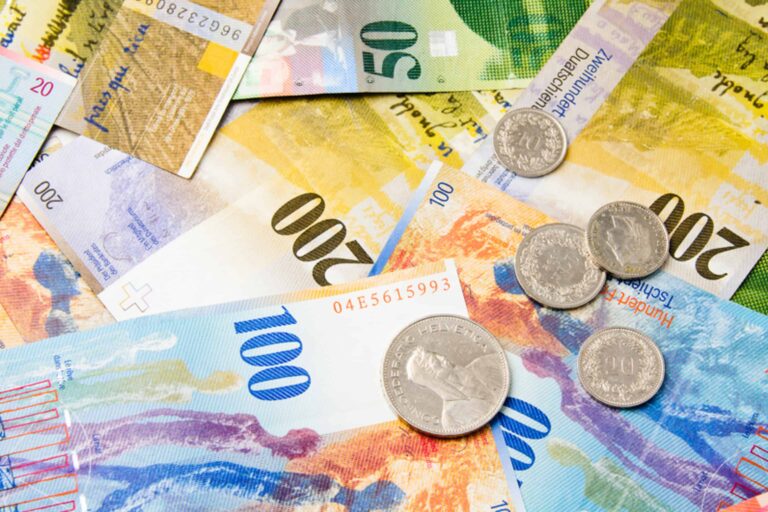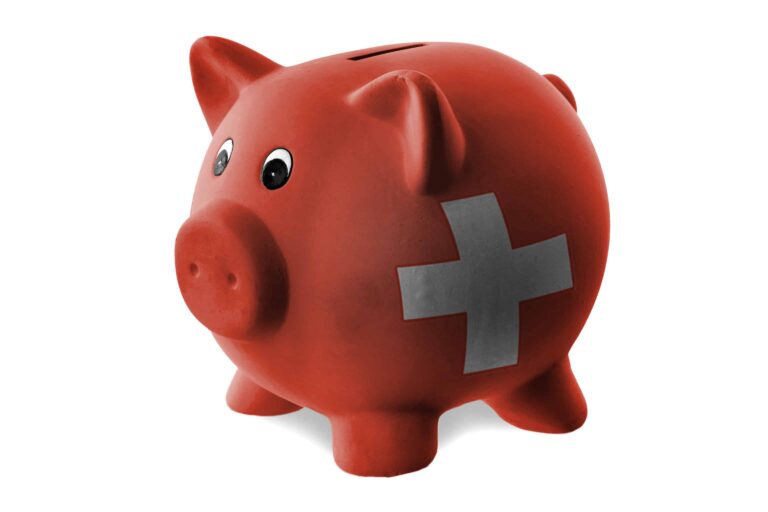Swiss franc or euro, what to use?
The Swiss franc is the only official currency in Switzerland (and in Liechtenstein), and the only currency accepted everywhere. The euro is the currency in the bordering countries Germany, France, Italy, and Austria, and in many other European countries.
Nevertheless, you can pay with euros in many shops, hotels, rail stations, and gas stations in Switzerland. This is convenient if you’re only in transit or only staying for one night. Many smaller shops, market stalls, kiosks, et cetera only allow payment in Swiss francs.
The euro is a foreign currency in Switzerland, so accepting it results in extra costs and risks for shop owners. Therefore, if you pay with euros, change will be in Swiss francs and the exchange rate is mostly not in your favor.
For longer stays, it is cheaper and more convenient to have Swiss francs at hand.
How to pay in Switzerland
1. Credit and debit cards
Credit cards and debit cards are widely accepted, so there is no need to have large amounts of cash at hand. You can pay larger amounts by cards and take along some cash for smaller payments and places that do not accept cards.
2. Mobile payment
Payment by mobile wallets is getting more common in Switzerland. Examples are Apple Pay, Google Pay, and Samsung Pay. The appropriate mPOS (“mobile points of sale”) terminals are not available everywhere yet. So make sure you have other payment options too.
If contactless payment is possible, you can use your mobile device. In most cases, this is connected to a credit card or prepaid card. Some mobile wallets require authentication when you pay. This can be a PIN code or fingerprint scan, for example.
3. Cash
Swiss francs can be obtained from ATMs. They are available in all towns. You can usually find them at post offices, rail stations, and shopping centers. In general, this is the cheapest way to obtain cash. Your bank can provide exact fees. To save time upon arrival, it can be handy to purchase some Swiss francs before you depart.
Your bank may charge fees for both cash withdrawals through ATMs and credit/debit card payments.
How we deal with payment in Switzerland ourselves
When we come to Switzerland, we have a small amount of Swiss francs when we cross the border: around CHF 100 per person. We have 2 debit cards: one from our bank and one from Wise: see below. We use those for most payments, and to withdraw some extra cash if needed.
We use cash only if there’s no other way to pay. We never use our credit card, although we do have one as an emergency option.
Cheapest way to pay in Switzerland: Wise
Why Wise is different from other banks
Arno and I recommend the Wise debit card because it’s cheap and easy to understand.
Wise (formerly TransferWise) offers an online bank account that can hold many currencies. A low fee is charged when converting money from one currency to another. Wise charges the actual exchange rate, while most banks charge a lower rate in order to keep the difference themselves (a hidden fee). Wise has no fees for spending money using their debit card, e.g. when paying in Swiss francs from your Swiss francs balance.
So, you can convert your home currency to Swiss francs for a low fee. Then you can spend those francs without any further costs. This is much cheaper than most other banks and credit cards. Please find prices here: https://wise.com/pricing/.
Depending on where you live, Wise and similar options might count as a foreign bank account. Make sure you understand your home country’s tax and reporting requirements.
How to use Wise
- Open a Wise account for free: https://wise.com/account/.
- Order a debit card for a small one-time payment.
- Deposit money in your home currency into your account for free.
- Convert any amount to Swiss francs for a low fee. I recommend doing this when the exchange rate to your home currency is in your favor. You can even set up an automatic conversion that executes when the exchange rate reaches your desired value. Find exchange rates here: https://wise.com/currency-converter/currencies/chf-swiss-franc.
- Once you’re in Switzerland, use your card to pay from your Swiss francs balance for free. The card works wherever Visa is accepted. It may not work if a shop only accepts V Pay or Maestro cards, which is rare. You can get cash from ATMs. This is free for low amounts, or otherwise, a fair fee will be applied. The card can be used online too, wherever the merchant asks for a debit card or credit card.
- Once you return home, convert your remaining Swiss francs balance back to your home currency for a low fee. Again, you can wait to do so until the exchange rate is best for you. Of course, you can also skip this step and hold on to your Swiss francs until your next trip.
The Swiss franc symbol, notes, and coins
The Swiss franc abbreviation: CHF
The symbol for the Swiss franc is “CHF”. The official currency code (ISO currency standard) is “CHF” as well. Alternatively, the abbreviation “Fr.” is widely used as a symbol as well.
“CH” stands for “Confoederatio Helvetica”: the Latin name for the Swiss Confederation. “F” stands for “Franken”, which is German for “franc”.
Swiss franc notes and coins
Notes
- 10 francs
- 20 francs
- 50 francs
- 100 francs
- 200 francs
- 1000 francs
Coins
One-hundredth of a Swiss franc is called a rappen (German), centime (French), or centesimo (Italian).
- 0.05 francs, 5 rappen
- 0.10 francs, 10 rappen
- 0.20 francs, 20 rappen
- 0.50 francs, 50 rappen
- 1 franc
- 2 francs
- 5 francs
Is Switzerland expensive?
The Swiss franc is a strong currency, so Switzerland is not cheap for visitors from many other countries. There are many ways to save money on your holidays in Switzerland though.

